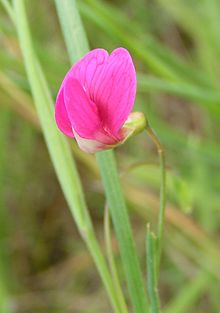Lathyrus
| Lathyrus | |
|---|---|

| |
| Grass vetchling (Lathyrus nissolia) | |
| Scientific classification | |
| Kingdom: | Plantae |
| Clade: | Tracheophytes |
| Clade: | Angiosperms |
| Clade: | Eudicots |
| Clade: | Rosids |
| Order: | Fabales |
| Family: | Fabaceae |
| Subfamily: | Faboideae |
| Tribe: | Fabeae |
| Genus: | Lathyrus L.[1] |
| Species | |
|
See text | |
| Synonyms[1] | |
| |
Lathyrus /ˈlæθɪrəs/[2] is a genus of flowering plants in the legume family Fabaceae, and contains approximately 160 species. Commonly known as peavines or vetchlings,[1] they are native to temperate areas, with a breakdown of 52 species in Europe, 30 species in North America, 78 in Asia, 24 in tropical East Africa, and 24 in temperate South America.[3] There are annual and perennial species which may be climbing or bushy. This genus has numerous sections, including Orobus, which was once a separate genus.[4]
Uses[]
Many species are cultivated as garden plants. The genus includes the garden sweet pea (Lathyrus odoratus) and the perennial everlasting pea (Lathyrus latifolius). Flowers on these cultivated species may be rose, red, maroon, pink, white, yellow, purple or blue, and some are bicolored. They are also grown for their fragrance. Cultivated species are susceptible to fungal infections including downy and powdery mildew.
Other species are grown for food, including the Indian pea (L. sativus) and the red pea (L. cicera), and less commonly (L. ochrus) and Spanish vetchling (L. clymenum). The tuberous pea (L. tuberosus) is grown as a root vegetable for its starchy edible tuber. The seeds of some Lathyrus species contain the toxic amino acid oxalyldiaminopropionic acid and if eaten in large quantities can cause lathyrism, a serious disease.[5]
Diversity[]






Species include:[6]
- Lathyrus angulatus – angled pea
- – red fodder pea
- Lathyrus aphaca – yellow pea
- – golden pea
- Lathyrus belinensis
- Lathyrus biflorus – twoflower pea
- Lathyrus bijugatus – drypark pea
- – ciliate vetchling
- – Bonneville pea
- Lathyrus cicera – red pea
- Lathyrus clymenum – Spanish vetchling
- – arvejilla
- – prairie vetchling
- Lathyrus delnorticus – Del Norte pea
- – seemly vetchling, bush vetchling
- – grassleaf pea
- Lathyrus grandiflorus – twoflower everlasting pea
- – Grimes' pea
- – Norfolk everlasting pea
- Lathyrus hirsutus – hairy vetchling
- – Bullfrog Mountain pea
- – thinleaf pea
- Lathyrus japonicus – sea pea, beach pea
- Lathyrus jepsonii – delta tule pea
- – aspen pea
- Lathyrus laevigatus
- Lathyrus lanszwertii – Nevada pea
- Lathyrus latifolius – everlasting pea, perennial pea
- Lathyrus libani – Lebanon vetchling
- Lathyrus linifolius – bitter vetch, heath pea
- Lathyrus littoralis – silky beach pea
- – Lord Anson's blue pea
- Lathyrus nevadensis – Sierra pea
- Lathyrus niger – black pea
- Lathyrus nissolia – grass vetchling
- – cream pea
- – Cyprus-vetch
- Lathyrus odoratus – sweet pea
- Lathyrus palustris – marsh pea
- Lathyrus pauciflorus – fewflower pea
- Lathyrus pisiformis
- Lathyrus polyphyllus – leafy pea
- Lathyrus pratensis – meadow vetchling
- – tiny pea, singletary vetchling
- Lathyrus rigidus – stiff pea
- Lathyrus sativus – Indian pea, white pea, chickling vetch
- Lathyrus sphaericus – grass pea
- Lathyrus splendens – pride of California
- Lathyrus sulphureus – snub pea
- Lathyrus sylvestris – flat pea
- Lathyrus tingitanus – Tangier pea
- Lathyrus torreyi – Torrey's peavine
- Lathyrus tuberosus – tuberous pea
- Lathyrus undulatus – wavy pea
- – Korean mountain vetchling[7]
- – veiny pea, bushy vetchling
- Lathyrus vernus – spring pea
- Lathyrus vestitus – Pacific pea
Jewish law[]
Lathyrus can be mixed with bitter peas without violating the Jewish law of Kilayim.[8]
Ecology[]
Lathyrus species are used as food plants by the larvae of some Lepidoptera species, including the grey chi (Antitype chi) and the latticed heath (Chiasmia clathrata), both recorded on meadow vetchling (Lathyrus pratensis), and Chionodes braunella.
Notes[]
- ^ a b c "genus Lathyrus". Germplasm Resources Information Network (GRIN) online database. Retrieved 10 March 2017.
- ^ Sunset Western Garden Book, 1995:606–607
- ^ Asmussen, C. B; A. Liston. (March 1998). "Chloroplast DNA characters, phylogeny, and classification of Lathyrus (Fabaceae)". American Journal of Botany. 85 (3): 387–401. doi:10.2307/2446332. JSTOR 2446332. PMID 21684923.
- ^ Fred, Edwin Broun; Baldwin, Ira Lawrence; McCoy, Elizabeth (1932). Root Nodule Bacteria and Leguminous Plants. UW-Madison Libraries Parallel Press. p. 142. ISBN 978-1-893311-28-2.
- ^ Barrow, M. V.; et al. (1974). "Lathyrism: A Review". The Quarterly Review of Biology. 49 (2): 101–128. doi:10.1086/408017. JSTOR 2820941. PMID 4601279. S2CID 33451792.
- ^ GRIN Species Records of Lathyrus. Archived 2008-10-14 at the Wayback Machine Germplasm Resources Information Network (GRIN).
- ^ English Names for Korean Native Plants (PDF). Pocheon: Korea National Arboretum. 2015. p. 511. ISBN 978-89-97450-98-5. Archived from the original (PDF) on 25 May 2017. Retrieved 22 December 2016 – via Korea Forest Service.
- ^ Mishnayot Kilayim 1:1
External links[]
 Media related to Lathyrus at Wikimedia Commons
Media related to Lathyrus at Wikimedia Commons- Calflora Database: Lathyrus species index
- Jepson Flora Project: Key to Lathyrus
- Lathyrus
- Fabaceae genera
- Garden plants
- Taxa named by Carl Linnaeus
